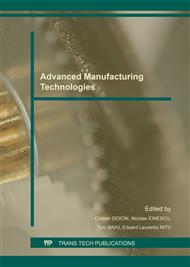p.126
p.132
p.141
p.147
p.153
p.161
p.167
p.173
p.181
Comparative Analysis of Short and Longweld Hardness
Abstract:
Short rows and multiple layers fixture welding is characterized by a non-stationary thermal field, compared to the long welds, characterized by quasi-stationary thermal field, excluding the end zones characterized by a non-stationary thermal field.Up to the present, welded tests are made for homologating welding processes or for welders authorizations or validity prolongations of welders authorizations or certifications, these being made on 500 mm long welded samples, where the 20 mm parts at the beginning and at the end of the sample are removed and no test specimens for mechanical test are made of them. The present article studies the values of HV 10 Vickers hardness in these beginning and end zones of the weld (crater) when the welding is made without putting on the technological plates at the beginning and at the end, compared to the values of HV 10 Vickers hardness measured in the middle part of the weld..
Info:
Periodical:
Pages:
153-158
Citation:
Online since:
April 2016
Authors:
Keywords:
Price:
Сopyright:
© 2016 Trans Tech Publications Ltd. All Rights Reserved
Share:
Citation:


